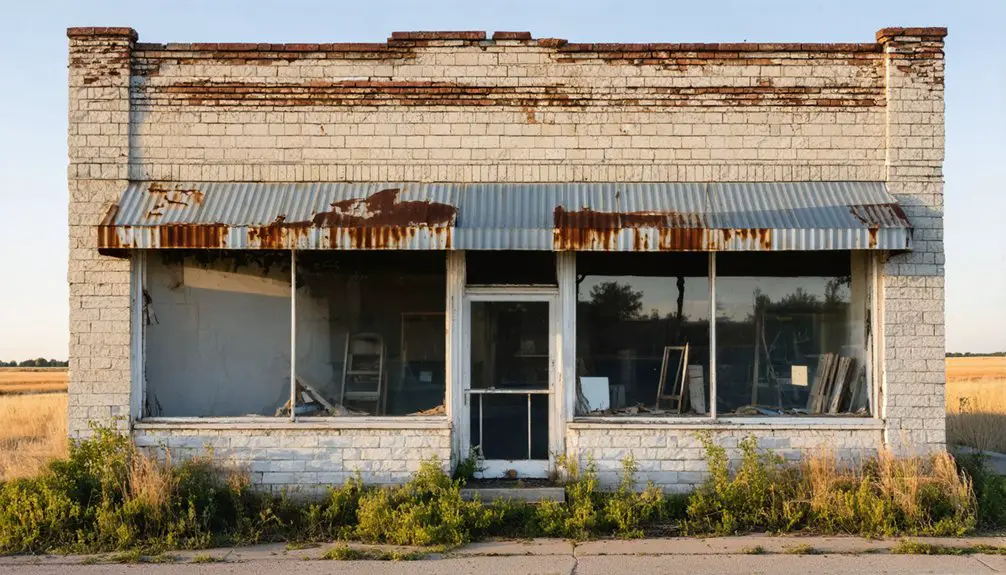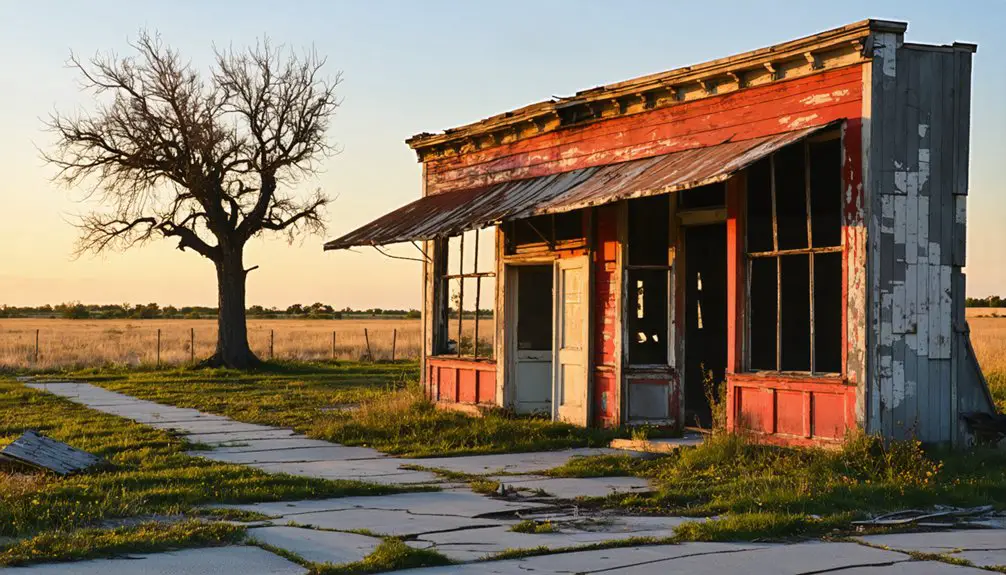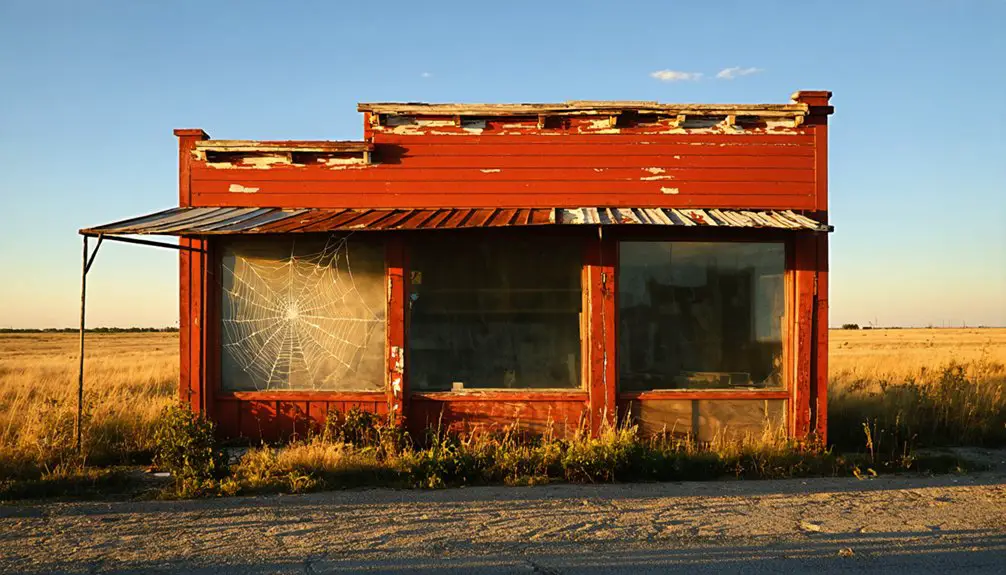You’ll find Strawberry’s story begins in 1861 when pioneers settled along Parsons Creek, naming their town for the abundant wild strawberries growing there. The community thrived through the 1870s, reaching 1,258 residents by 1880, with a grist mill, sawmill, and three stores supporting local commerce. Economic challenges, poor transportation access, and the Great Depression led to its complete abandonment by 1951. The remnants of this Kansas ghost town hold fascinating tales of pioneer life and rural transformation.
Key Takeaways
- Strawberry, Kansas was established in 1861 along Parsons Creek and completely disincorporated by 1951 due to economic decline.
- The town reached its peak population of 1,258 residents in 1880 before declining during the Great Depression and Dust Bowl.
- Named for abundant wild strawberries, the settlement supported three stores, a grist mill, and sawmill during its prime.
- Poor transportation access and lack of economic diversification led to the town’s abandonment and ghost town status.
- The Strawberry Hill mansion, built in 1887 and later converted to an orphanage in 1919, marked the town’s affluent period.
Origins and Early Settlement
When settlers first arrived in Washington County during the spring of 1861, they established the town of Strawberry on fertile prairie land bisected by Parsons Creek. Among the first pioneers was the Peter Gieber family, who arrived that May to face the settlement challenges of transforming raw prairie into farmable land.
The area’s natural abundance of wild strawberries made it particularly appealing to early settlers seeking opportunities. The settlers likely encountered wild varieties similar to Fragaria virginiana, which was native to North America. Like many early Kansas settlements, the pioneers faced uncertainty since land claims could not be officially verified until proper surveys were completed.
The pioneer lifestyle quickly attracted others, as the population grew from 436 initial residents to 934 by 1878. Within just two more years, the settlement reached its peak of 1,258 people.
The town’s position along Parsons Creek, which flowed south to the Republican River, provided essential water access that supported the growing farming community.
A Town Named for Wild Berries
The wild strawberries that flourished along Parsons Creek gave Strawberry its distinctive name, reflecting the area’s natural abundance.
You’ll find these berries weren’t just any ordinary fruit – they were hardy perennials that thrived in the prairie’s fertile soil, producing red, fleshy berries roughly half to three-quarters of an inch in diameter.
The wild strawberry ecology perfectly suited the area’s temperate climate and moist conditions near the creek.
First settlers in May 1861 discovered the area’s rich potential for farming and community building.
These native plants supported local wildlife and became an essential part of the region’s identity.
Like the strawberries that led to the first hybrid cultivation by Antoine Nicolas Duchesne in 1766, these wild berries demonstrated remarkable adaptability to their environment.
The berries’ cultural significance ran deep – they symbolized the land’s fertility to early settlers and represented the simple beauty of rural life.
Unlike many towns named after founders or geographic features, Strawberry’s name captured the essence of its natural heritage.
Peak Years and Community Life
After the town’s establishment in 1861, you’d have seen Strawberry’s population grow rapidly to 934 residents by 1878, reaching its peak of 1,258 around 1880.
The Missouri Pacific Railroad station served as the community’s economic lifeline, supporting local farmers who brought their crops to market and merchants who operated shops along the main street. The area’s history of affluent residents is evident in the construction of the Queen Anne style mansion known as Strawberry Hill in 1887.
You’d have found daily life revolving around agricultural work and railroad commerce, with families gathering at local churches and schools that dotted the prairie landscape. The mansion later transitioned into a children’s orphanage in 1919, serving the community’s most vulnerable residents.
Population Growth and Prosperity
During its existence as a country hamlet, Strawberry maintained a modest but stable presence in Washington County, Kansas, situated 12 miles southwest of the county seat.
While historical demographic trends for the original settlement aren’t well documented, today’s Strawberry Township shows signs of significance with 112 residents and a steady 0.9% annual growth rate.
The township encompasses 36.13 square miles of Washington County’s territory.
You’ll find interesting contrasts between the ghost town’s past and the current township’s prosperity. The area has overcome economic challenges that typically plagued similar Kansas settlements, boasting a 0% poverty rate.
Similar to how Croatian immigrants established communities in Kansas, early settlers helped shape the region’s cultural identity.
With a median age of 46.9 years and a population increase of 1.82% since 2020, the township demonstrates resilience where the original hamlet couldn’t survive.
Though the old town’s buildings are gone, the surrounding region continues to adapt and grow.
Local Trade and Commerce
Strawberry’s economic significance centered around three main stores, a grist mill, and a sawmill that served both residents and travelers passing through Washington County.
Like St. John the Baptist Church, churches and schools doubled as trading hubs, where residents would gather to exchange news and conduct business.
You’d find local farmers bringing their grain to the grist mill for processing into flour, while the sawmill supported construction needs throughout the area. Similar to Cedar Point Bank, these businesses formed the backbone of rural Kansas commerce. The town’s local markets thrived on barter systems, where community members exchanged livestock, farm equipment, and household goods at the general stores.
The postal service connected Strawberry to wider trade networks, enabling commerce beyond local boundaries.
Local merchants stocked essential supplies, from tools to dry goods, sustaining daily life in this frontier community.
Daily Agricultural Activities
As settlers established themselves in Strawberry’s fertile prairie soil from 1861 onward, they developed a robust agricultural system centered on grain cultivation and livestock management.
You’d find farmers rising before dawn to tend to their animals, feeding cattle, pigs, and poultry while maintaining barns and pens.
Crop management dominated daylight hours, with seasonal tasks including planting in spring, weeding in summer, and harvesting in fall.
During peak periods, you’d see neighbors helping neighbors, sharing labor for intensive tasks like wheat harvesting.
Horse-drawn plows turned the prairie soil while families rotated crops to maintain soil health.
When winter arrived, you’d find farmers repairing equipment and planning for the next growing season, all while continuing daily livestock care through the harsh Kansas weather.
The Path to Abandonment

While the town of Strawberry enjoyed early success with its 1861 founding and subsequent population growth to 1,258 residents by 1880, multiple factors converged to trigger its eventual abandonment.
From frontier prosperity to ghost town, Strawberry’s dramatic rise and fall mirrors the fleeting nature of western settlement dreams.
You’ll find that dramatic population shifts began around 1910, when only 52 residents remained. The town’s isolation from major transportation routes and railways severely limited its economic potential, while the agricultural foundation couldn’t sustain the community through changing market conditions and the devastating Great Depression.
Economic decline accelerated during the Dust Bowl era, leading to complete disincorporation by 1951.
- Poor transportation access cut off essential trade routes and commerce opportunities
- Lack of economic diversification left the town vulnerable to agricultural market changes
- Failure to secure county seat status prevented administrative growth and regional influence
Natural Features and Geography
Located in Washington County, Kansas, the natural landscape of Strawberry reveals a classic prairie environment with fertile soils and vital water features.
You’ll find Parsons Creek flowing through the town center, eventually making its way south to join the Republican River. The area’s rich prairie soils and natural resources have long supported diverse agricultural practices.
The region’s temperate climate brings cold winters and warm summers, while moderate precipitation maintains the delicate balance of the ecosystem.
You’ll notice the land is mainly flat, creating ideal conditions for farming, though you’ll need to watch for soil erosion.
Wild strawberries once grew abundantly here, giving the town its name, while native prairie grasses and wildflowers still dot the landscape.
The presence of streams guarantees reliable groundwater access, essential for sustaining local agriculture.
Legacy Among Kansas Ghost Towns

Once a thriving agricultural settlement, Strawberry stands as a tribute to the rise and fall of pioneer communities in Kansas.
You’ll find its cultural significance deeply woven into Washington County’s historical fabric, where it persisted from 1861 until its disincorporation in 1951. Unlike short-lived boomtowns, Strawberry’s ninety-year lifespan tells a detailed story of agricultural development and rural transformation in America’s heartland.
- Historical preservation efforts continue to document Strawberry’s peak population of 1,258 in 1880, highlighting its importance in early Kansas statehood.
- The town’s decline mirrors broader patterns of rural depopulation and infrastructure challenges across the Midwest.
- Strawberry’s legacy informs modern discussions about sustainable rural development and the impact of transportation networks on community survival.
Frequently Asked Questions
Are Any Original Buildings From Strawberry Still Standing Today?
You won’t find any original buildings standing today, as there’s no historical preservation of architecturally significant structures. The town’s disincorporation in 1951 led to complete deterioration of all remaining edifices.
Did Native American Tribes Inhabit the Area Before Strawberry’s Settlement?
Ever wonder who roamed these free plains first? You’ll find Native tribes like the Kanza and Osage held historical significance in eastern Kansas, inhabiting the region before settlers established Strawberry.
What Happened to the Residents Who Left Strawberry?
You’ll find that resident migration led families to nearby towns like Lazine and Walker, where they sought better infrastructure and jobs, while leaving behind only ghost stories and memories.
Were There Any Notable Crimes or Incidents During Strawberry’s Active Years?
You’ll be surprised to learn there weren’t any notable crimes or infamous incidents recorded during the town’s active years. The community remained peaceful, with only typical rural challenges affecting daily life.
Can Visitors Access the Former Town Site on Public or Private Land?
You’ll need permission to visit since there’s no public access to the site – it’s privately owned farmland. Entering without landowner consent would constitute trespassing under Kansas property laws.
References
- https://hauntedhouses.com/kansas/strawberry-hill-mansion/
- https://en.wikipedia.org/wiki/Strawberry
- https://en.wikipedia.org/wiki/List_of_ghost_towns_in_Kansas
- https://legendsofkansas.com/everyplace-in-kansas-s/
- https://www.geocaching.com/geocache/GCT06J
- https://dianastaresinicdeane.wordpress.com/2012/01/29/columbia-a-kansas-ghost-town-story/
- https://legendsofkansas.com/extinct-towns-washington-county/
- https://www.knotts.com
- https://dbpedia.org/page/Strawberry
- https://lostkansas.ccrsdigitalprojects.com/sites/lostkansas/files/private_static/2022-12/LT_WS_Strawberry_Whetstone.pdf



